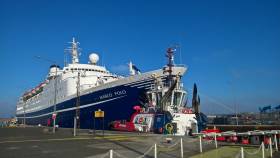Displaying items by tag: Port of Hull
Cowes Cargoship Caller Docked in Major UK Port of Hull to Open Rare Public Tours In October
#Ports&Shiping - Cowes Week synominous for the World famous regatta held in the UK off the Isle of Wight town is also home to Carisbrooke Shipping which today has one of their cargoships docked in the Port of Hull which on 21st October is to host public tours, writes Jehan Ashmore.
Tickets to visit the English port on the North Sea coast however have apparently been snapped up. To those who have secured tickets already from Associated British Ports (ABP) through Eventbrite, this will enable a rare behind-the-scenes opportunity to experience the huge scale of operations at the UK east coast port.
The four 90-minute tours held throughout the day will begin at ABP Port House in Hull (HU9 5NS), followed by an exciting coach tour of King George V Dock (pictured above) where the Carisbrooke cargoship, Kimberly C constructed in China in 2011 is at time of writing berthed in the dock's basin. The 6,800dwt gearless mini-bulker is one of 31 in the fleet of dry-cargo and multi-purpose ships that ranges from 5,000dwt to more than 13,000dwt.
Afloat has researched that the ship is due to depart the dock and head for Tilbury (London) on the Thames Estuary before a longer passage bound for Dublin Port next week.
King George V Dock is one of several docks that comprise the port complex includes the neighbouring Hull Container Terminal where Irish built ship-to-shore cranes were installed earlier this year. This involved a seaborne delivery of a pair of Liebherr (Killarney plant built cranes) conveyed on a heavy lift-ship HHL Lagos on a voyage from Rushbrooke, Cork Harbour to the UK port.
Returning to the port tours in Hull next month, they are to include stop-off points to fully gain a sense of the vast operations which according to ABP play such an important role in the UK and local economies.
The Port of Hull which is located on the Humber estuary is one of four ports operated by ABP, the others are located opposite on the south shore in Goole, Grimsby and Immingham. The latter port hosted a successful open day which saw over 500 people attend from across the UK.
#CruiseLiners - The deep blue-hulled Marco Polo, Cruise & Maritime Voyages veteran vessel as Afloat previously featured calling to Irish ports is among seven cruiseships that will use the UK Port of Hull this season, writes Jehan Ashmore.
The North Sea port located on the Humber estuary is operated by Associated British Ports (ABP) and has become an increasingly popular cruise calling destination and for those directly departing from the port in East Yorkshire. In order to further attract cruise-goers, ABP has invested in creating additional car parking for holidaymakers to ensure a stress-free trip embarking.
Marco Polo has called to the Port of Hull throughout the summer and Afloat will have more to report on a mini-cruise between Hull and Harwich in Essex.
In addition to CMV's Marco Polo, the first caller this season to Port of Hull was Silversea Cruises six-star expedition ship, Silver Cloud. The 250 passengers enjoyed a day trip to Hull, last year's UK City of Culture and to nearby historically-steeped York.
According to ABP, port apprentices and staff lined up to welcome the Silver Cloud passengers to Hull as they enjoyed canapés and jazz music prior to boarding. Also taking place was a traditional plaque exchange held on board between ABP, Silver Cloud’s Captain and Hull City Council’s Lord Mayor and Admiral of the Humber.
The 12 day Silversea Cruise toured the UK which concluded in the Pool of London where the 157m entered through the iconic Tower Bridge. Also this season, passengers boarded Silver Cloud from this central location on a cruise to include Ireland's Wild Atlantic Way.
Hull is centrally located port on the Humber and is already home to daily P&O Ferries operated routes to Zeebrugge and Rotterdam. Together these overnight services annually handle just under one million passengers travelling to Belgium and The Netherlands.





























































